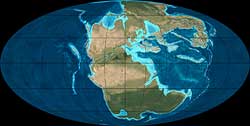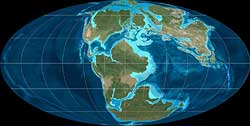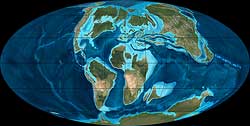The Mesozoic Era

|
|
Global paleogeographic reconstruction of the Earth in the late
Triassic period 220 million years ago.
(Courtesy Dr. Ron Blakey) |

|
| Global paleogeographic reconstruction of the Earth in the late Jurassic period 150 million years ago. (Courtesy Dr. Ron Blakey) |

|
| Global paleogeographic reconstruction of the Earth in the late Cretaceous period 90 million years ago. (Courtesy Dr. Ron Blakey) |
The Mesozoic Era is the age of the dinosaurs and lasted almost 180 million years from approximately 250 to 65 million years ago. This era includes 3 well known periods called the Triassic, Jurassic, and Cretaceous periods. A mass-extinction marked the beginning and end of the Mesozoic Era. The event that caused the transition from the Paleozoic era to the Mesozoic era was the greatest extinction this earth has seen. This extinction wiped out about 95% of all marine life and 70% of land-life. This allowed the dinosaurs to step in and settle into their role as the lords of the earth. The era ended with "The Great Extinction" which marked the end of the dinosaurs as the Cenozoic era began.
Tectonics
At the beginning of the Mesozoic era the continents as we know them were joined together as the massive mother continent, Pangaea. It was during the age of the dinosaurs that Pangaea was transformed to the modern continents. Pangaea became two great continents known as Laurasia and Gondwana and the Atlantic Ocean began to grow. Laurasia eventually split into the continents of North America and Eurasia. Gondwana became the modern continents of South America, Africa, Australia, Antarctica, and the India subcontinent, which, after the Mesozoic era, collided with Eurasia forming the Himalayas.
Environment
The environment was unusually warm and polar ice caps did not yet exist. This played a large part in evolution and is a key factor behind the flourishing of the dinosaurs. During the Triassic period the climate was generally dry, which changed near the Jurassic period as oceans began to rise due to mounting layers of magma covering the seafloor. As a result, flooding overtook many parts of the exposed land. This allowed the climate to change with increased humidity and it continued that way even into the Cretaceous period. However, the climate began to cool during the Cretaceous although temperatures may have risen again near the end of the Mesozoic.
| Proterozoic eon |
542 Ma - Phanerozoic eon - Present | |||||||||||
|---|---|---|---|---|---|---|---|---|---|---|---|---|
| 542 Ma - Paleozoic era - 251 Ma | 251 Ma - Mesozoic era - 65 Ma | 65 Ma - Cenozoic era - Present | ||||||||||
| Cambrian | Ordovician | Silurian | Devonian | Carboniferous | Permian | Triassic | Jurassic | Cretaceous | Paleogene | Neogene | Quaternary | |